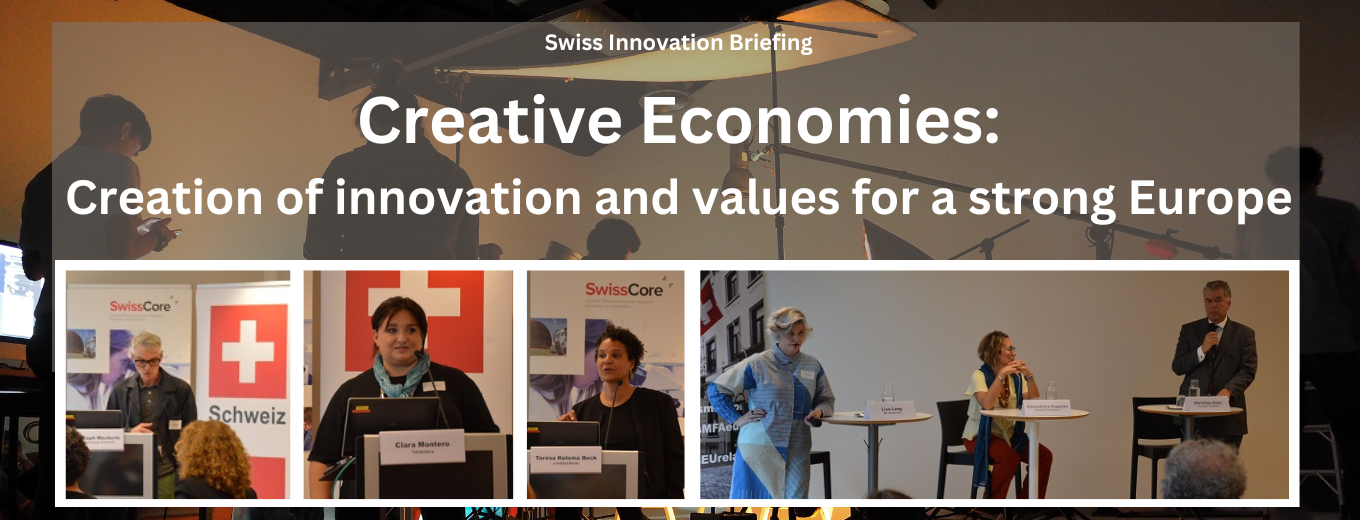In order to achieve the transformations of the green and digital transition, the EU attributes a leading role to the cultural and creative sectors.
2023 is an important year for the creative economies in Europe. The European Institute of Innovation and Technology (EIT) is setting up a 9th Knowledge and Innovation Community (KIC) dedicated to the cultural and creative sectors and industries in Europe (Culture and Creativity KIC) and the European Commission is moving forward with the New European Bauhaus initiative. In this context, representatives from universities of arts, cultural institutions and policy makers came together on 10 October 2023 at the Swiss Mission to the European Union to take stock of the creative economies across Europe and what role they are playing in creating innovation and value for society. Subsequently, experts from the European Parliament, the Commission and the EIT reflected on the European support for creative economies going forward.
Christoph Weckerle, the director of the Zurich Centre for Creative Economies (ZCCE) at the Zurich Universits of the Arts (ZhDK), kicked the event off by mapping and defining creative economies: They revolve around the three core concepts of i. experimenting to foster curiosity (experiment), ii. trying out new things (newness), and of creating spill-over effects across sector borders and with society. Weckerle also touched on the main challenges related to creative economies. They are open in-between places, with often project-based working conditions and great diversity of actors. Creative economies are for example at the intersection of arts and technogy, between the economic and the social. This in-between character leads to more complexity but also more opportunity. He therefore also advocated for a shift in looking at funding for creative industries and culture as an investment and not as a cost. Weckerle also critisies the term ‘atypical employment’ which is often used to describe the creative actors; as in reality frequently changing working conditions are becoming the new normal and therefore more typical. Finally, he called for the creation of a new soft power narrative in Europe based on its creative economies, as Europe is still a continent where creativity is valued for itself, not soley as an economic or innovation factor.
Teresa Koloma Beck, the research director of the Creative Impact Research Centre Europe (CIRCE), presented CIRCE’s work as an interdisciplinary and international network fostering Europe-wide collaboration on experimental and applied research on creative and cultural economies. CIRCE is funded by the German government and the EU’s Brexit adjustment reserve to preserve and further develop European networks within and beyond the EU. It is anchored in five research labs from all corners of Europe: the u-institut in Berlin, Garage48 in Tallinn, the University of London, Tabakalera in San Sebastian, and the above mentioned Zurich Centre for Creative Economies. CIRCE runs currently 13 pilot projects all applying creative practises to create novel social impact and socetial gain. These projects serve as examples of how creative economies in Europe can act as engines of technological and social innovation.
Clara Montero, the cultural director of Tabakalera in San Sebastian, showed the impressive ecosystem that an art centre can create for the local community engaging with businesses and citizens alike. In cooperative projects artists, designers and researchers develop and test prototypes that chart new ways for digitalisation and sustainability. Tabakalera reunites in one space studios, workshops and other production places, support with residency, mentorship and training programmes. But it pairs this with a digital library and citizens’ lab. In this lab citizens, artists and designers come and work together to create more social and sustainable innovation. The centre extends this openness also to collaborations in science, technology and industry – going beyond the classic model of sponsorship. Current examples for such real industry-arts partnerships are done in ‘robotics and trust’ for example.
Leading MEP Christian Ehler (EPP, Germany) provided an optimistic perspective on the creative sector. He stated that the creative economies have a huge economic relevance, especially cross-sectorially for other economic fields. Looking back, Ehler says that this was not always recongised but now the creative sector is among the core interests of the European Parlaiment. According to MEP Ehler, the creative economies are now placed in many EU programmes, such as for example the structural funds, Horizon Europe, digitals funds. STOA had assessed the sector in Europe statistically and came to the conclusion that it is one of the largest sectors of the European economy with € 35 billion, and a high number of employees under 35 years old with one of the highest growth rates. MEP Ehler states that one of the strengths of the sector is its bottom-up character engaging citizens which is very relevant for the green and digital transition that Europe needs to achieve. For this reason, MEP Ehler advocates for a doubling of the budget for the creative and cultural sectors in Horizon Europe.
In the discussion with the audience and the panel it became once again clear what an important role the creative economies are attributed by the European institutions. There was concensus voiced that the new Culture and Creativity KIC will be the most open and transformative innovation ecosystem of the EIT, working closely together with other KICs, such as the EIT Climate KIC, and funding open cross-sectoral calls for projects that have to bring together different disciplines. On 15 November 2023, a joint Climate KIC and C&C KIC event will take place.
More information on the event can be found here.

